Bronze beauties: Spotlighting the Senate Chamber’s two chandeliers

In February 2019, the Senate moved to the Senate of Canada Building, a former train station built in 1912. The Senate will occupy this temporary location while Parliament’s Centre Block — the Senate’s permanent home — is rehabilitated.
Although Centre Block is shuttered for rehabilitation work, Canadians can still experience its art and architecture through the Senate’s immersive virtual tour.
For nearly 100 years, two enormous bronze and cast-iron chandeliers have hung from the magnificent gilded ceiling of the Senate Chamber in Centre Block, illuminating the room’s stunning features.
Despite being central fixtures in the Red Chamber for so long, the origins of the identical chandeliers remained a bit of a mystery — that is, until experts took a closer look and uncovered more details before the huge lights were temporarily dismantled as part of Centre Block’s rehabilitation.
It turns out the custom chandeliers represent an extraordinary three-tonne feat of lighting manufacturing, according to the co-founder of the company contracted to oversee their removal.
“It’s hard for me to find anything more spectacular than these Senate chandeliers,” said Chris Nelson, whose company, Lighting Nelson & Garrett, specializes in lighting design and restoration and has worked on heritage projects across the country.
“There’s an art to these that’s really worth celebrating.”
During Centre Block’s reconstruction following the destructive fire of 1916, chief architect John A. Pearson travelled to New York City to discuss designs for the new Senate Chamber chandeliers with the Mitchell Vance Company, a renowned American lighting manufacturer at the time.
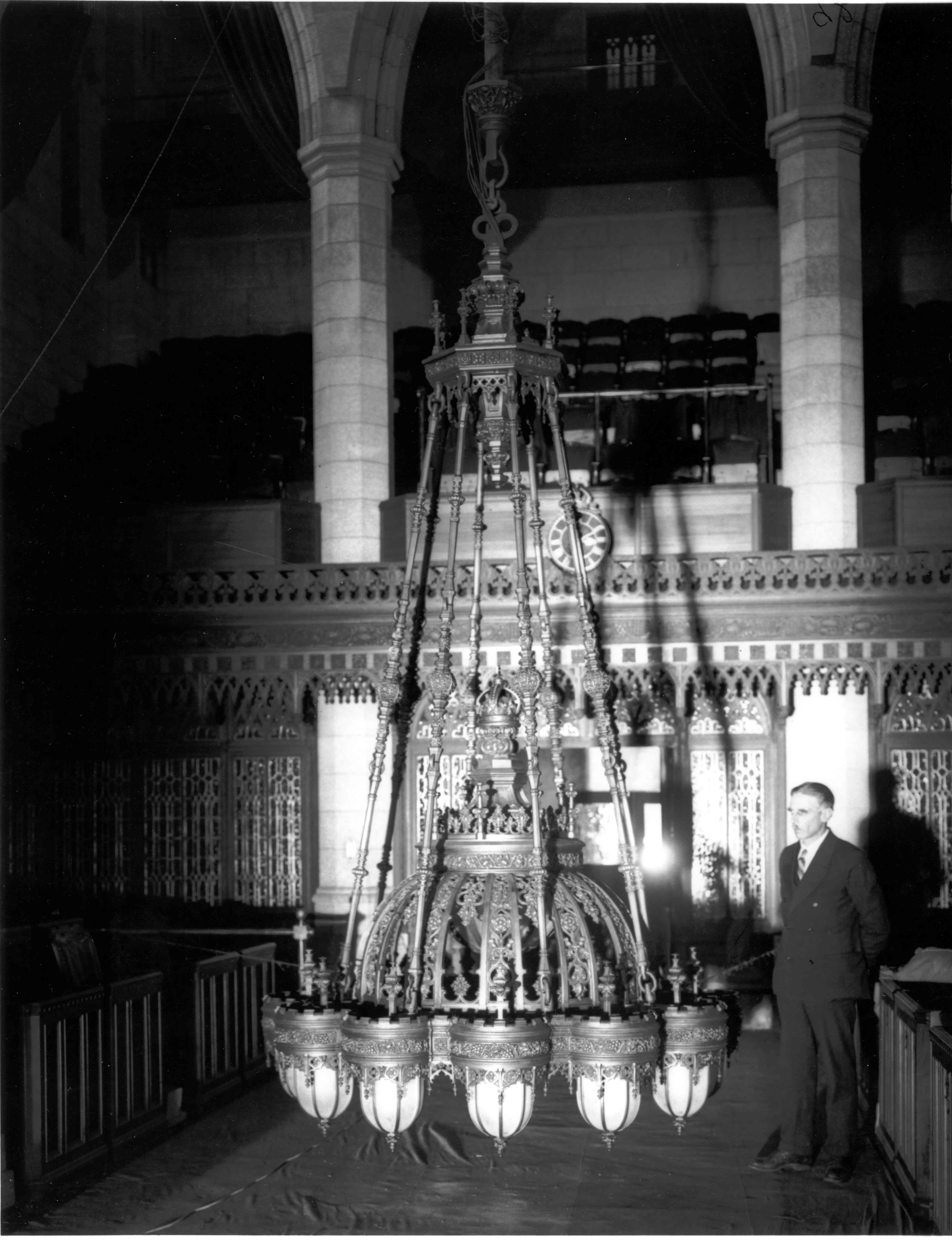
The Department of Public Works ultimately selected the final design from Mitchell Vance but contracted a Canadian firm, the Robert Mitchell Company, to manufacture the massive fixtures.
Craftsman Cléophas Soucy — who oversaw Centre Block’s carving team and became Parliament’s first Dominion Sculptor — modelled the intricate chandelier in clay. The model was then cast and assembled at the Robert Mitchell metal foundry in Montreal.
To achieve the desired finish, the fixtures were burnished with nitrate of copper under the supervision of Paul Beau, Parliament’s head ironmaster. Once ready, the chandeliers were shipped in pieces to Ottawa and installed in the Senate Chamber in 1926.
How exactly engineers hoisted the fixtures, though, is still unclear. Almost a century later, Mr. Nelson and his team had to devise a plan of attack from scratch in order to remove the chandeliers for protection and restoration.
Find out how they pulled it off, and take a closer look at the features that place these chandeliers among Parliament’s heritage masterpieces:
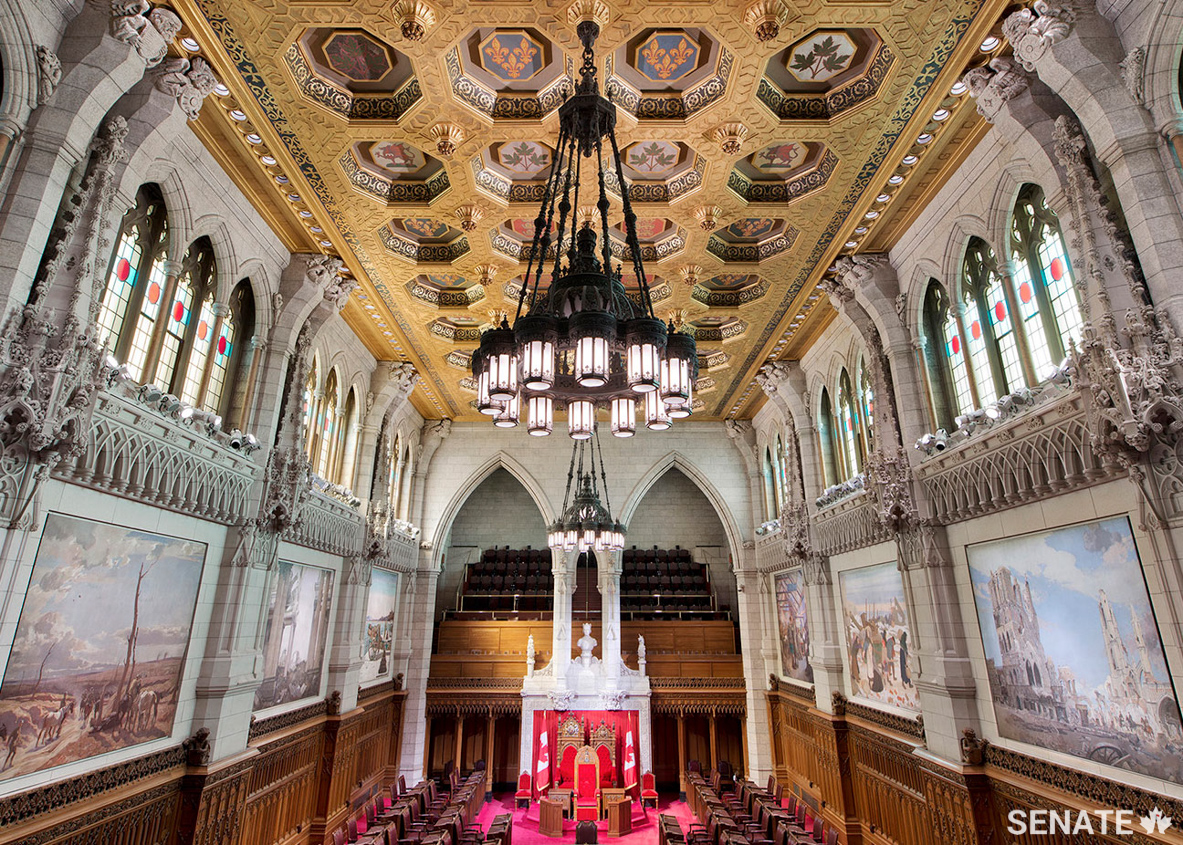
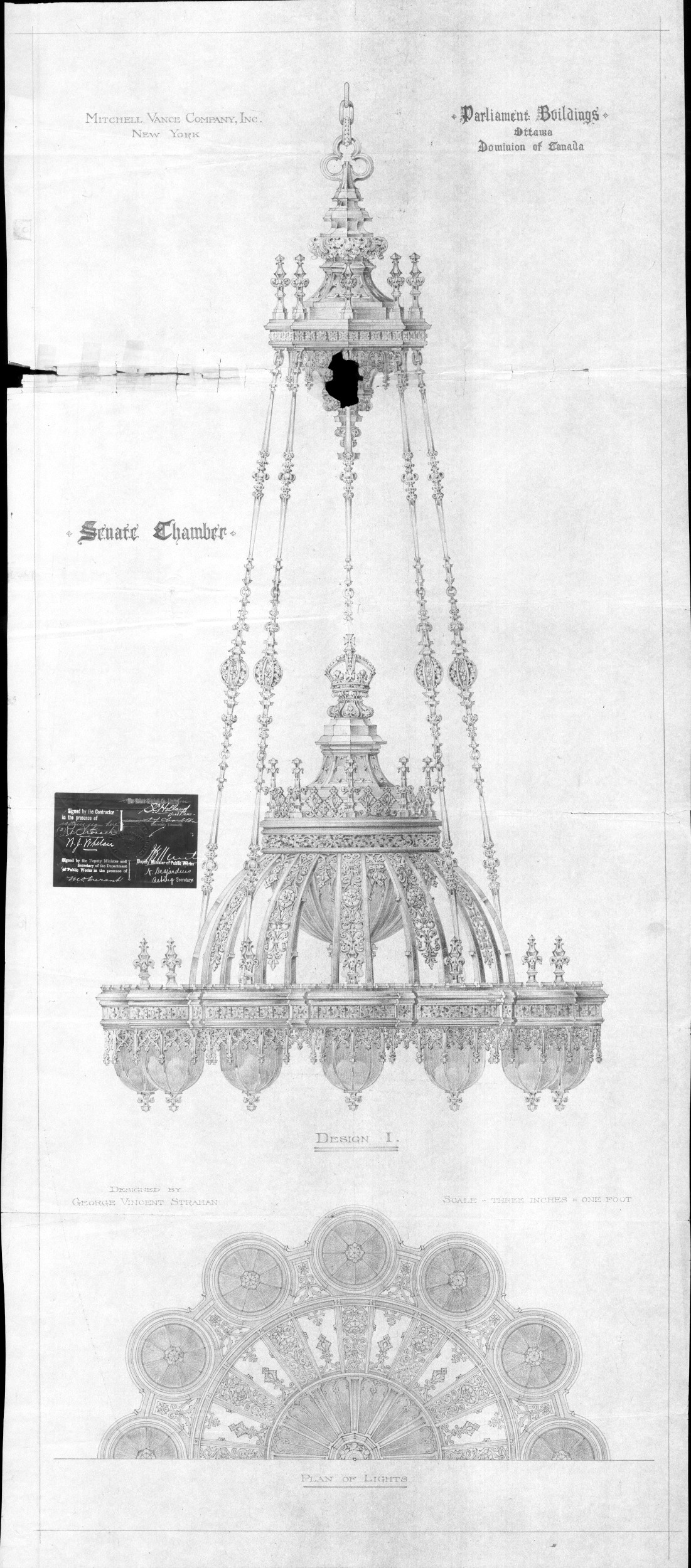
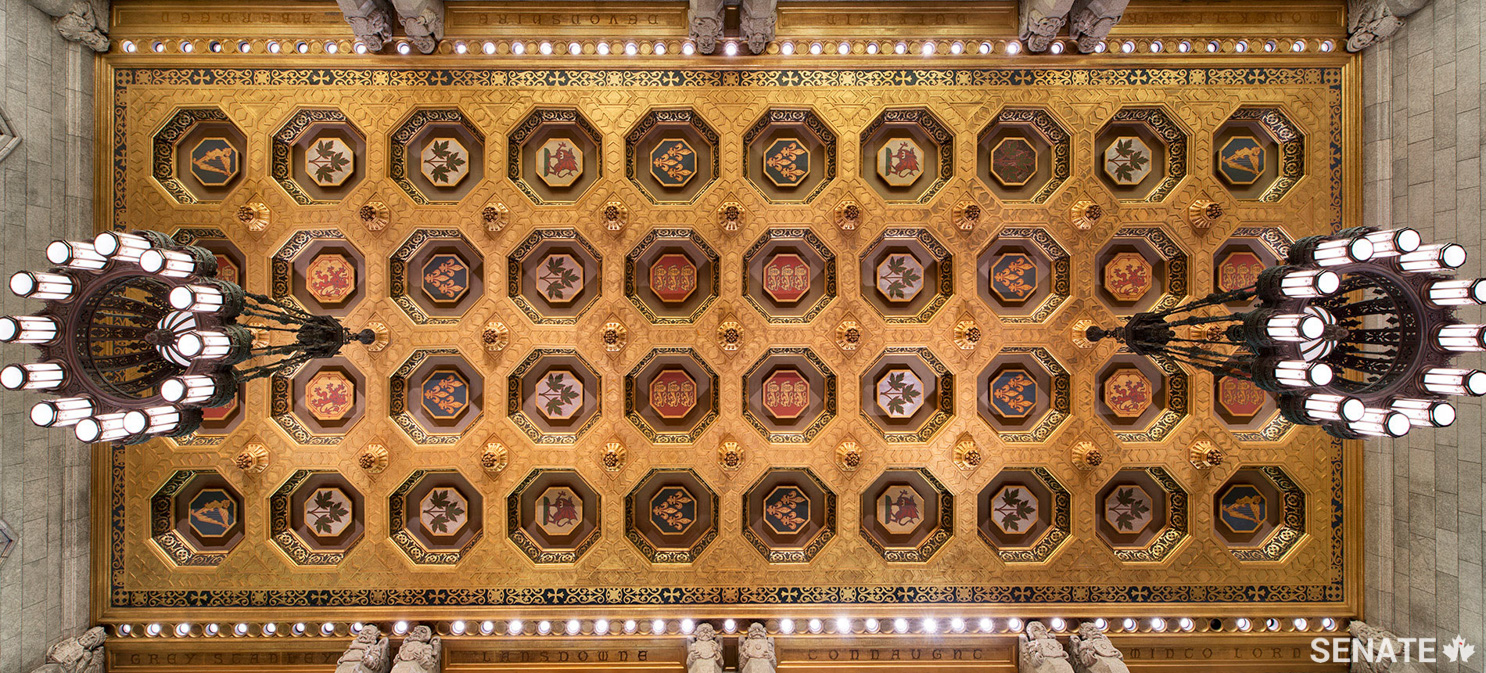 The 12 lanterns on each chandelier were upgraded in 1959 to cylindrical shades so the fixtures would project more light. The chandeliers, which also hold a single globe at their centre, are normally suspended about 5.5 metres from the ceiling on eight hanging rods.
The 12 lanterns on each chandelier were upgraded in 1959 to cylindrical shades so the fixtures would project more light. The chandeliers, which also hold a single globe at their centre, are normally suspended about 5.5 metres from the ceiling on eight hanging rods.
 Centre Block’s major rehabilitation means the two chandeliers can’t hang around. To reduce the load when lowering the fixtures to the ground, workers unfasten as many heavy pieces as possible and remove the fragile lanterns. (Photo credit: Public Services and Procurement Canada)
Centre Block’s major rehabilitation means the two chandeliers can’t hang around. To reduce the load when lowering the fixtures to the ground, workers unfasten as many heavy pieces as possible and remove the fragile lanterns. (Photo credit: Public Services and Procurement Canada)
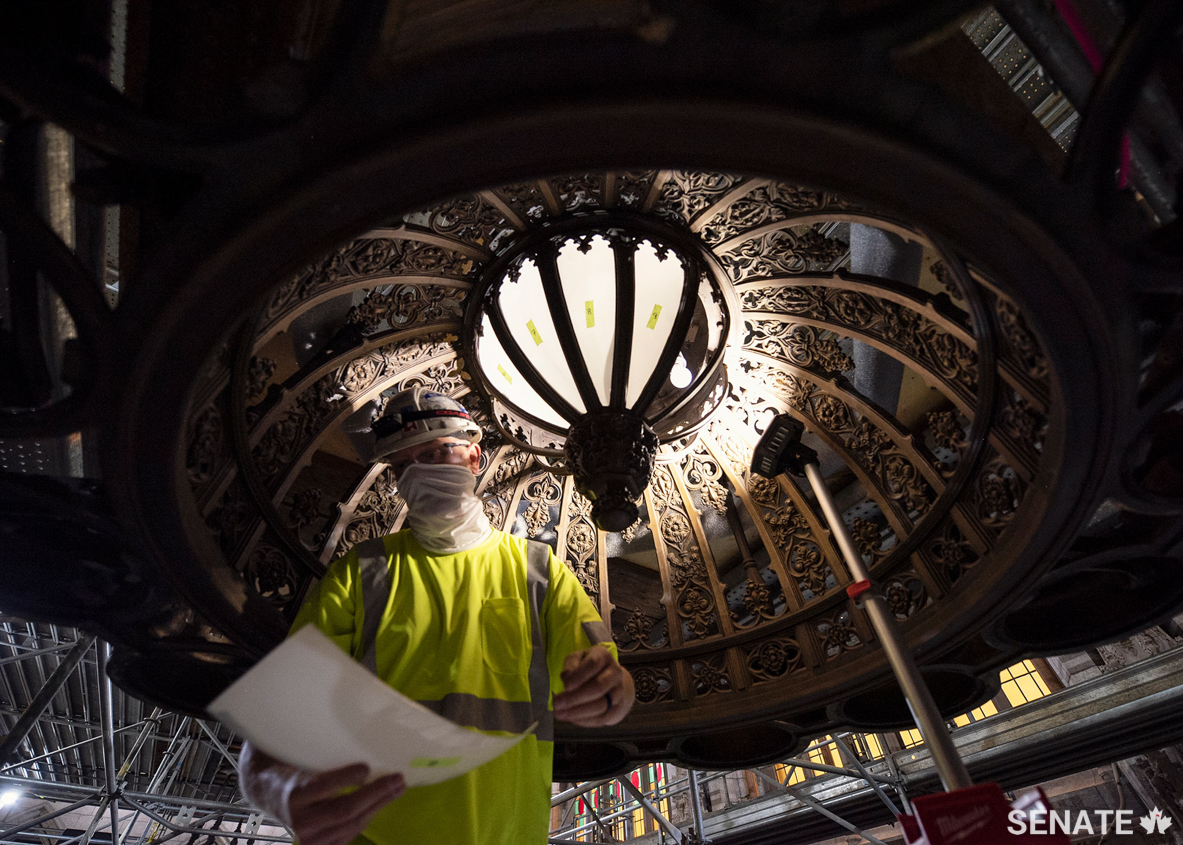 Conservators estimate the chandelier’s dome alone weighs 365 kilograms, while the scalloped ring — from which the lanterns hang — weighs slightly more. Workers on site followed all safety and public health rules that were in place at the time of the chandeliers’ removal.
Conservators estimate the chandelier’s dome alone weighs 365 kilograms, while the scalloped ring — from which the lanterns hang — weighs slightly more. Workers on site followed all safety and public health rules that were in place at the time of the chandeliers’ removal.
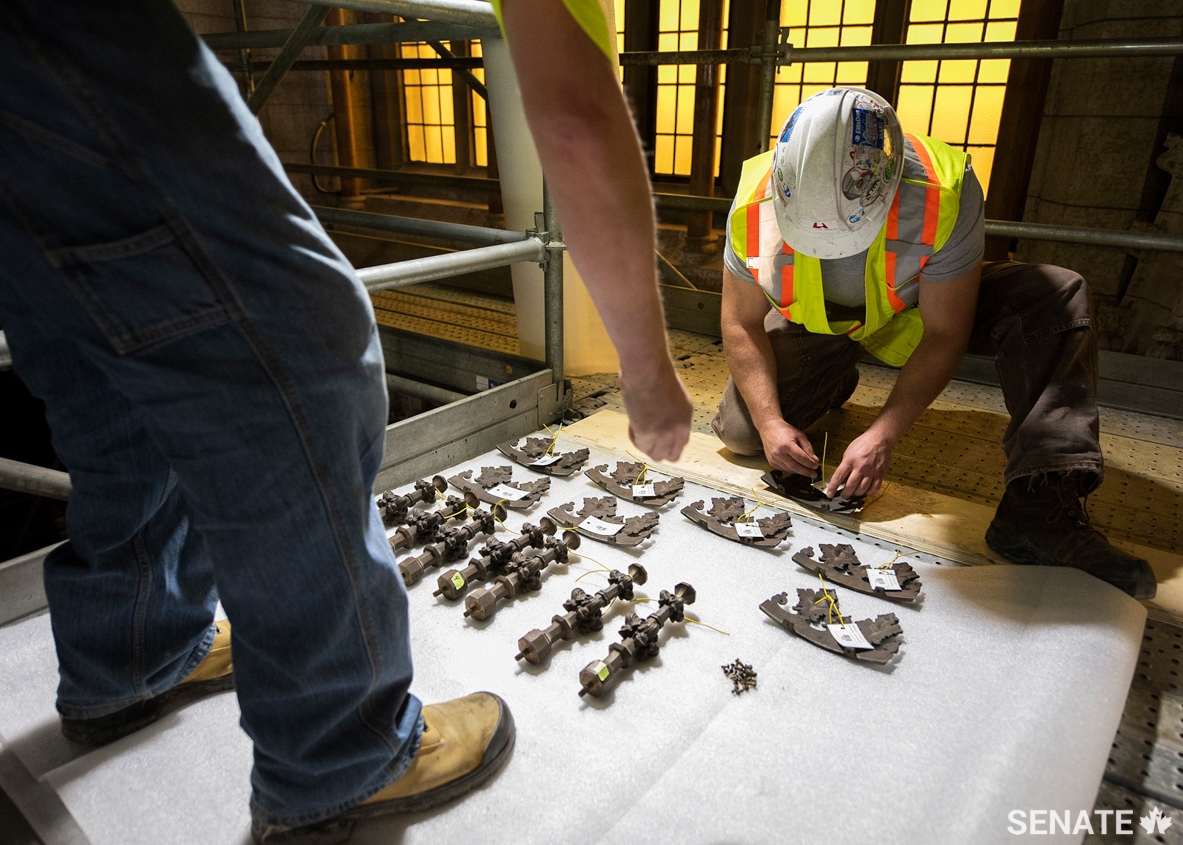 Workers carefully document smaller components of the Senate chandeliers, taking note of any number-and-letter combinations found stamped on pieces and the parts to which they fasten. The days-long dismantling process is like a 3-D jigsaw puzzle: challenging, but “fun,” according to Mr. Nelson.
Workers carefully document smaller components of the Senate chandeliers, taking note of any number-and-letter combinations found stamped on pieces and the parts to which they fasten. The days-long dismantling process is like a 3-D jigsaw puzzle: challenging, but “fun,” according to Mr. Nelson.
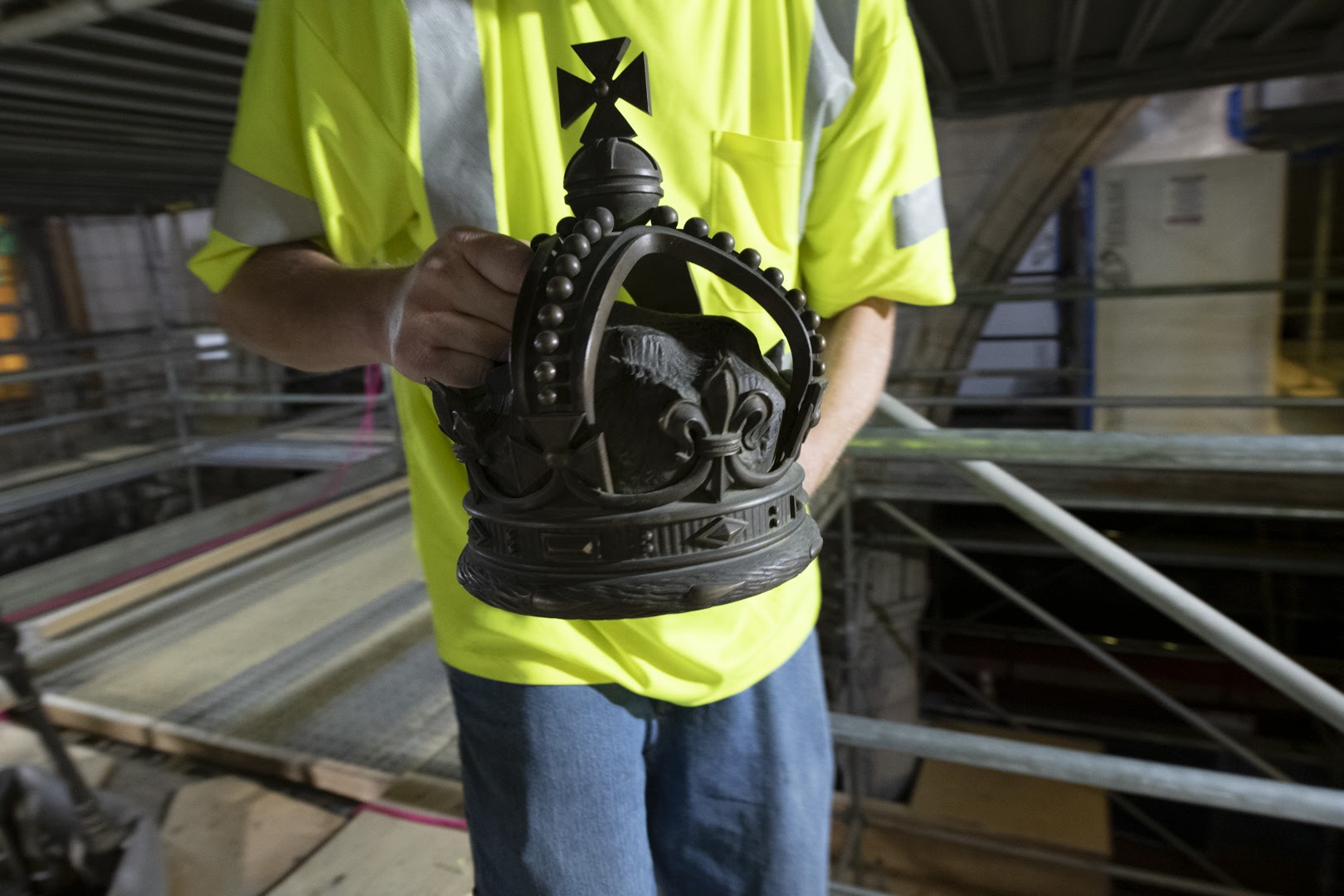
A worker holds the crown that caps the top of the chandelier’s dome. The cross that rests on the top of the crown must face the Speaker of the Senate, who enforces the Red Chamber’s rules and presides over proceedings. (Photo credit: Public Services and Procurement Canada)
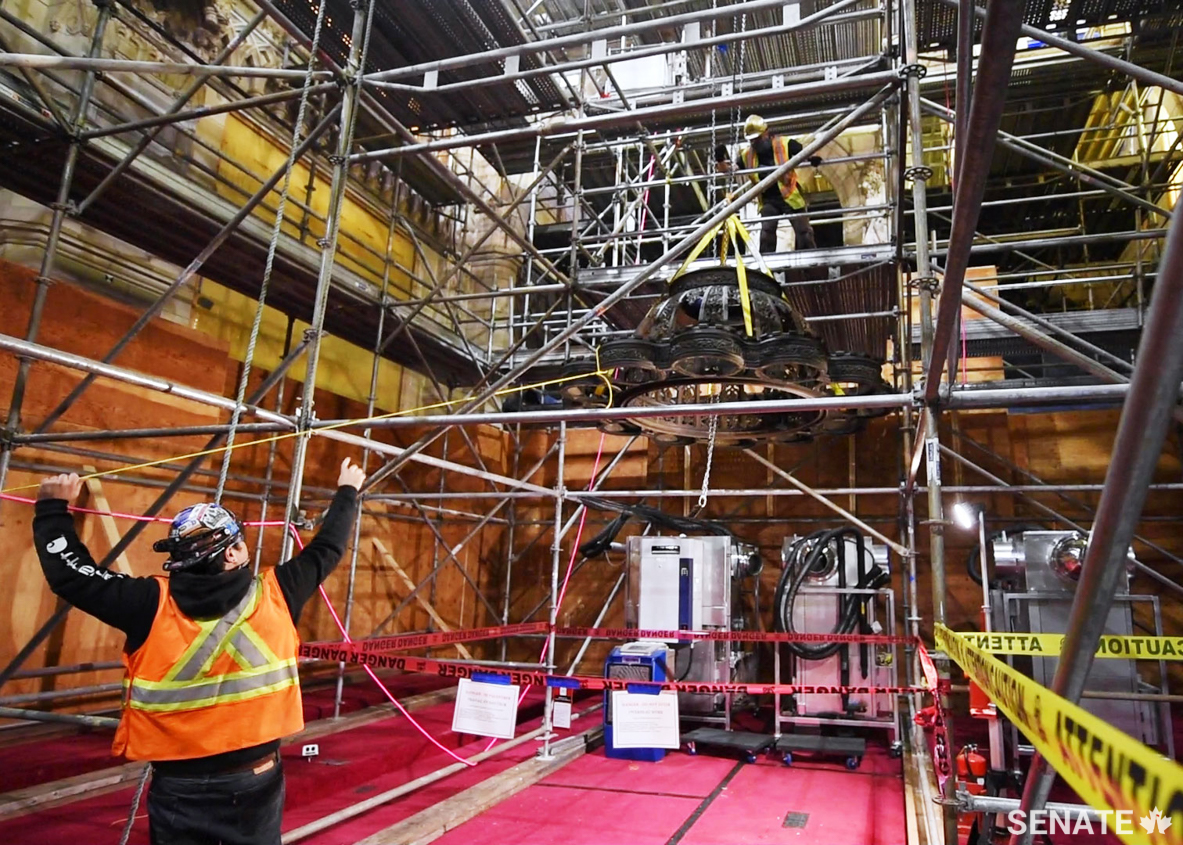 Workers slowly lower one of the stripped-down chandeliers using a heavy-duty chain pulley system. Structural nylon straps — akin to ultra-durable seatbelts — are wrapped around the strongest components of the chandelier and hooked to the pulley system.
Workers slowly lower one of the stripped-down chandeliers using a heavy-duty chain pulley system. Structural nylon straps — akin to ultra-durable seatbelts — are wrapped around the strongest components of the chandelier and hooked to the pulley system.
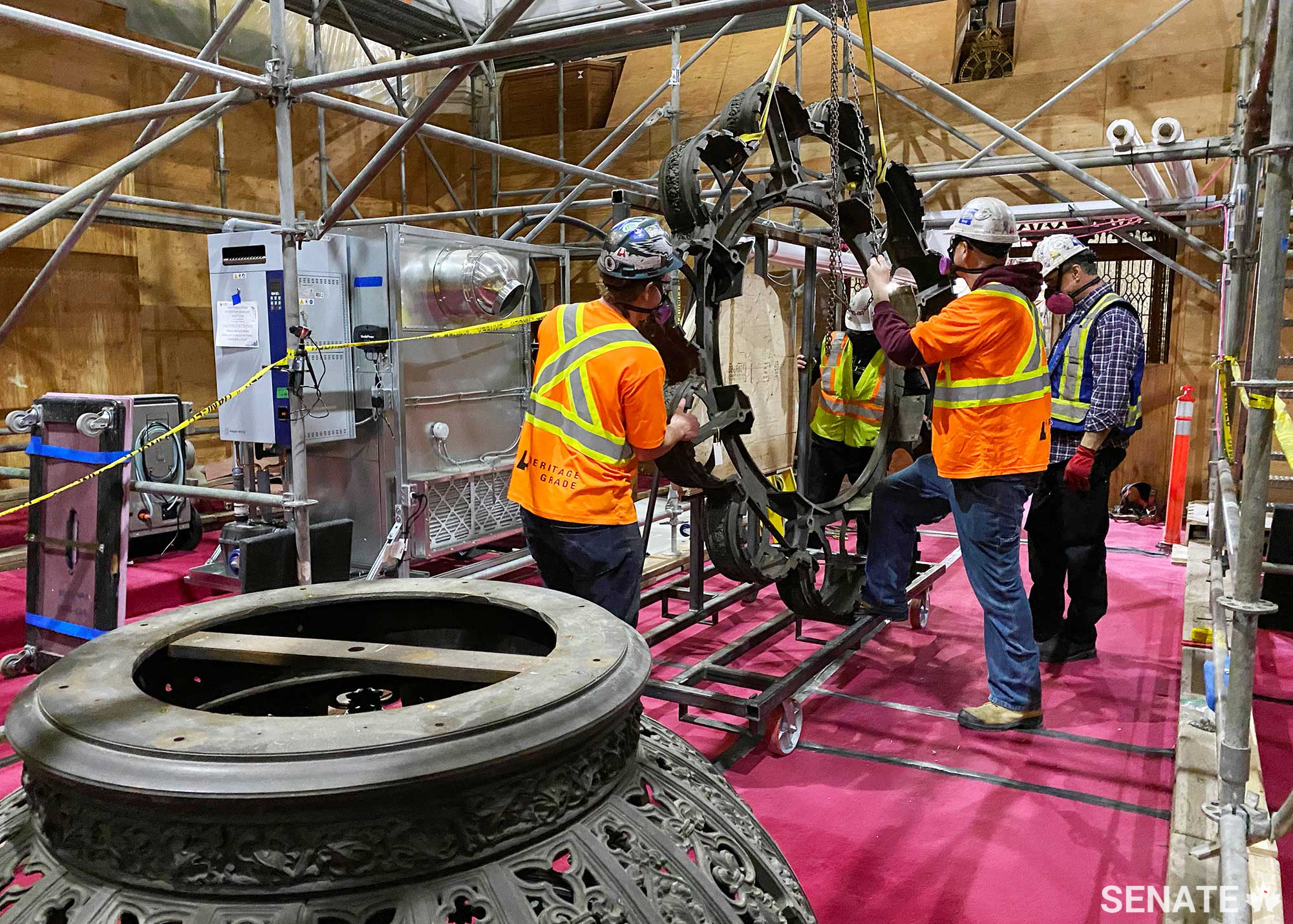 With the chandelier resting on a dolly, workers secure the giant ring to a custom-built frame on wheels. The ring, about 2.75 metres in diameter, was cast in one piece when it was forged — a feat “almost unheard of” for a lighting fixture, Mr. Nelson said. “That was one heck of a foundry at the Robert Mitchell Company, I can tell you.”
With the chandelier resting on a dolly, workers secure the giant ring to a custom-built frame on wheels. The ring, about 2.75 metres in diameter, was cast in one piece when it was forged — a feat “almost unheard of” for a lighting fixture, Mr. Nelson said. “That was one heck of a foundry at the Robert Mitchell Company, I can tell you.”
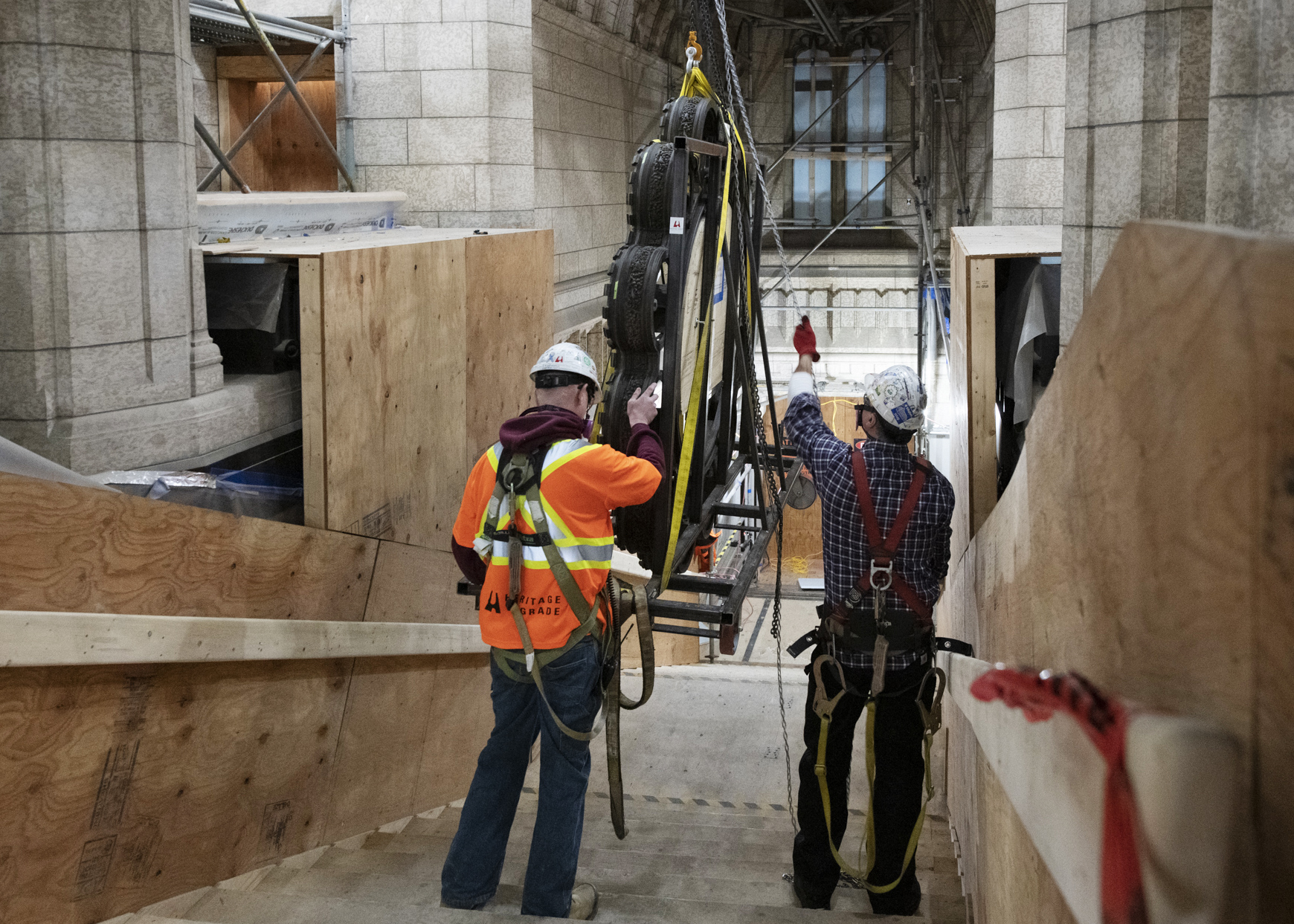 Workers navigate the next challenge: getting the ring and the frame down the stairs of the Senate foyer and out of the building. The crew devised another custom pulley system for that purpose, which includes an overhead track so the frame can glide over and down the staircase. (Photo credit: Public Services and Procurement Canada)
Workers navigate the next challenge: getting the ring and the frame down the stairs of the Senate foyer and out of the building. The crew devised another custom pulley system for that purpose, which includes an overhead track so the frame can glide over and down the staircase. (Photo credit: Public Services and Procurement Canada)
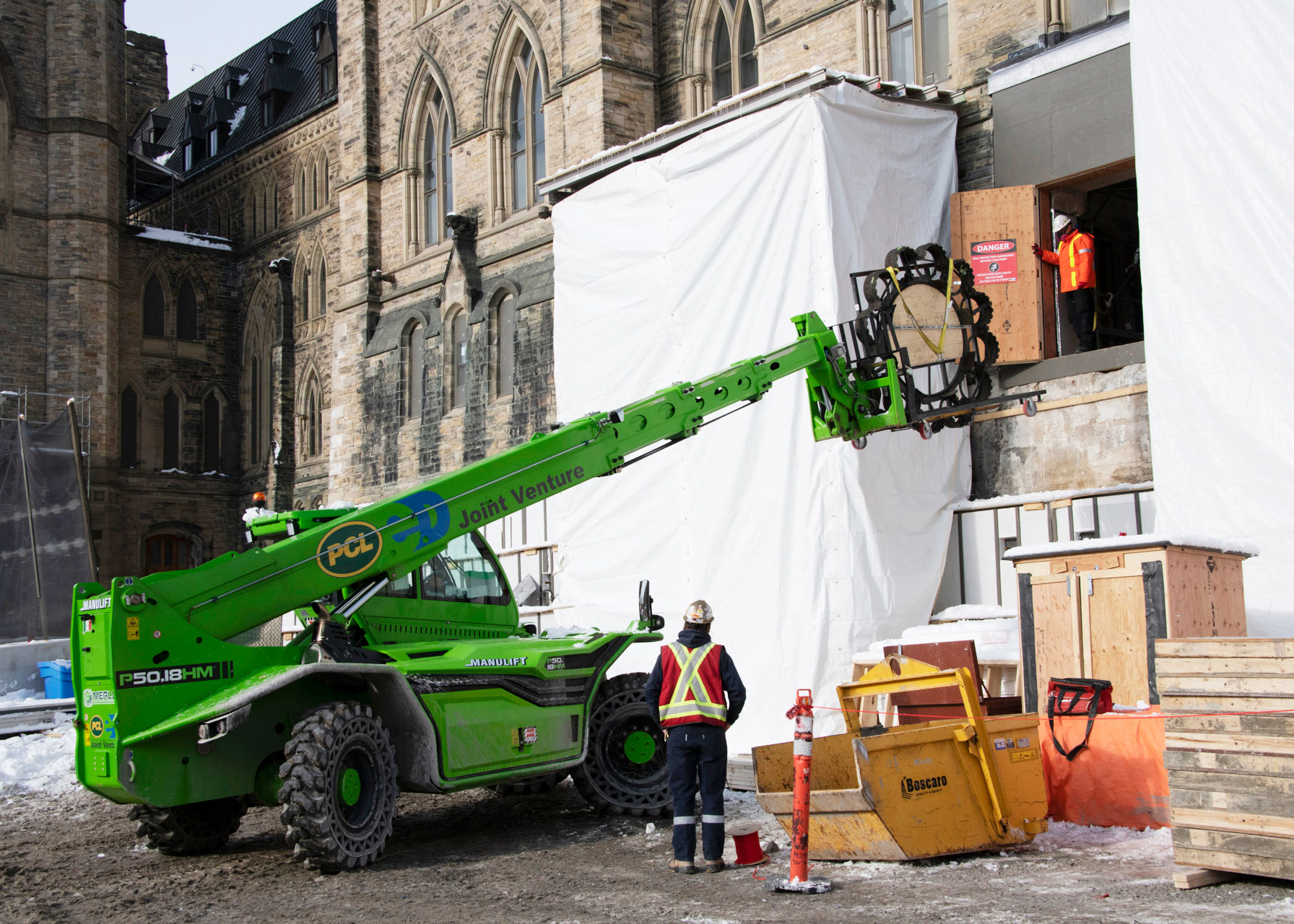 One of the heavy chandelier rings finally exits the building through the Senate entrance on Centre Block’s east side. The entrance is typically at ground level but appears elevated due to excavation work. (Photo credit: Public Services and Procurement Canada)
One of the heavy chandelier rings finally exits the building through the Senate entrance on Centre Block’s east side. The entrance is typically at ground level but appears elevated due to excavation work. (Photo credit: Public Services and Procurement Canada)
 Workers crate one of the chandelier rings for storage. Different components of the Senate chandeliers are being stored in a federal warehouse while restoration plans are finalized. (Photo credit: Public Services and Procurement Canada)
Workers crate one of the chandelier rings for storage. Different components of the Senate chandeliers are being stored in a federal warehouse while restoration plans are finalized. (Photo credit: Public Services and Procurement Canada)


